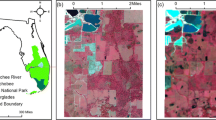Abstract
Land use land cover analysis aided by remote sensing provides the civic authorities a broader picture of the geographic area. This work aims to get the land cover map of the Bangalore Urban region using multispectral remotely sensed images. Three individual classifiers, namely random forest classifier, support vector machine classifier and the k-nearest neighbour, have been used. For the study area under consideration, the spectral signatures (which is the basis for classification) of water, vegetation and soil are not very distinct, which may cause misclassification. Also, the study area has imbalanced classes, because of which the individual classifiers may not give optimal results. The novelty of this work lies in the handling of these two shortcomings. A random unweighted hard MV (Overall accuracy = 82.75), priority-based unweighted hard MV (Overall accuracy = 86.06) and weighted hard MV (Overall accuracy = 86.92) classifiers are implemented here, and it is shown that they provide a better overall accuracy compared to the individual classifiers.



Similar content being viewed by others
References
L.-J. Ferrato, K.W. Forsythe, Comparing hyperspectral and multispectral imagery for land classification of the lower Don River, Toronto. J. Geogr. Geol. 5, 92–107 (2013)
V. Starovoitov, A. Makarau, Multispectral image pre-processing for interactive satellite image classification. Digit. Earth Summit Geoinf. 369–374 (2008)
E. Adam, O. Mutanga, D. Rugege, Multispectral and hyperspectral remote sensing for identification and mapping of wetland vegetation: a review. Wetl. Ecol. Manag. 18, 281–296 (2010)
C. Song, C.E. Woodcock, K.C. Seto, M.P. Lenney, S.A. Macomber, Classification and change detection using Landsat TM data: when and how to correct atmospheric effects? Remote Sens. Environ. 75, 230–244 (2001)
N.E. Young, R.S. Anderson, S.M. Chignell, A.G. Vorster, R. Lawrence, P.H. Evangelista, A survival guide to Landsat preprocessing. Ecology 98(4), 920–932 (2017)
R. Xinjiang, S. Tian, X. Zhang, J. Tian, Q. Sun, Random forest classification of wetland landcovers from multi-sensor data in the arid. Remote Sensing 8(1), 954 (2016)
M. Mahdianpari, B. Salehi, F. Mohammadimanesh, M. Motagh, Random forest wetland classification using ALOS-2 L-band, RADARSAT-2 C-band, and TerraSAR-X imagery. ISPRS J. Photogramm. Remote Sens. 130, 13–31 (2017)
M. Belgiu, L. Drăgu, Random forest in remote sensing: a review of applications and future directions. ISPRS J. Photogramm. Remote Sens. 114, 24–31 (2016)
S. Han, H. Kim, On the optimal size of candidate feature set in random forest. Appl. Sci. 9(5), 898 (2019)
D. Ming, T. Zhou, M. Wang, T. Tan, Land cover classification using random forest with genetic algorithm-based parameter optimization. J. Appl. Remote Sens. 10(3), 035021 (2016)
M. Pal, P.M. Mather, Support vector machines for classification in remote sensing. Int. J. Remote Sens. 26(5), 1007–1011 (2005)
B. Waske, J.A. Benediktsson, J.R. Sveinsson, Classifying remote sensing data with support Lecture Notes in Computer Science. (Springer, Berlin, 2009), pp.375–384
B.R. Shivakumar, G. Nagaraja, Sensitivity analysis of support vector machines on Landsat 8 image classification in original multidimensional feature space: a Kernel approach -part 1”. Int. J. Anal. Exp. Modal Anal. 11, 3983–3991 (2019)
K. Kulkarni, P.A. Vijaya, Using combination technique for land cover classification of optical multispectral images. Int. J. Appl. Geospatial Res. 12(4), 22–39 (2021)
M. Hudait, P.P. Patel, Crop-type mapping and acreage estimation in smallholding plots using Sentinel-2 images and machine learning algorithms: some comparisons. Egypt. J. Remote Sensing Space Sci. 25(1), 147–156 (2022)
Y. Zhong, Q. Cao, J. Zhao, A. Ma, B. Zhao, L. Zhang, Optimal decision fusion for urban land-use/land-cover classification based on adaptive differential evolution using hyperspectral and LiDAR data. Remote Sens. 9, 868 (2017)
Y. Mo, R. Zhong, H. Sun, Q. Wu, L. Du, Y. Geng, S. Cao, Integrated airborne LiDAR data and imagery for suburban land cover classification using machine learning methods. Sensors 2019, 19 (1996)
L. Yu, J. Su, C. Li, L. Wang, Z. Luo, B. Yan, Improvement of moderate resolution land use and land cover classification by introducing adjacent region features. Remote Sens. 10, 414 (2018)
K. Kulkarni, P.A. Vijaya, Separability analysis of the band combinations for land cover classification of satellite images. Int J Eng Trends Technol 69(8), 138–144 (2021)
K. Kulkarni, P.A. Vijaya, Using combination technique for land cover classification of optical multispectral images. Int. J. Appl. Geospatial Res. (IJAGR) 12(4), 22–39 (2021)
Acknowledgements
The authors are greatly indebted B N M Institute of Technology for providing the necessary infrastructure to carry on the research work. The authors also thank the Visvesvaraya Technological University (VTU) for providing us the suitable platform to conduct research.
Author information
Authors and Affiliations
Corresponding author
Additional information
Publisher's Note
Springer Nature remains neutral with regard to jurisdictional claims in published maps and institutional affiliations.
Rights and permissions
Springer Nature or its licensor (e.g. a society or other partner) holds exclusive rights to this article under a publishing agreement with the author(s) or other rightsholder(s); author self-archiving of the accepted manuscript version of this article is solely governed by the terms of such publishing agreement and applicable law.
About this article
Cite this article
Kulkarni, K., Vijaya, P.A. A Majority Voting Ensemble Approach for LULC Classification of Satellite Images. J. Inst. Eng. India Ser. B 104, 327–333 (2023). https://doi.org/10.1007/s40031-023-00865-4
Received:
Accepted:
Published:
Issue Date:
DOI: https://doi.org/10.1007/s40031-023-00865-4




